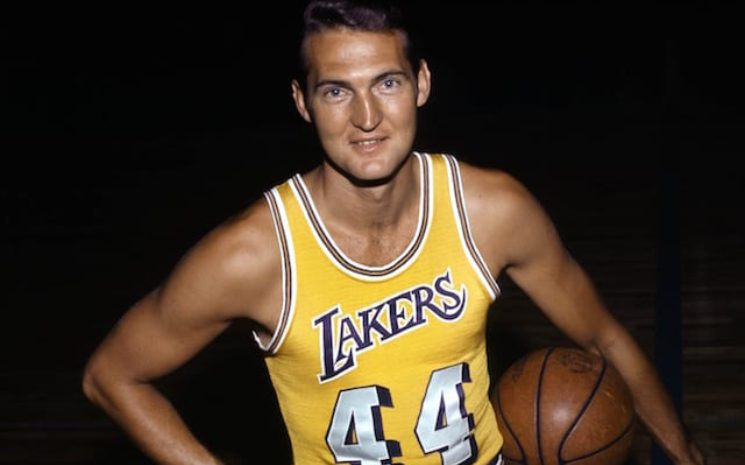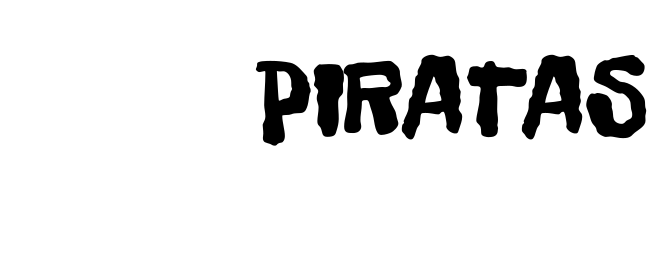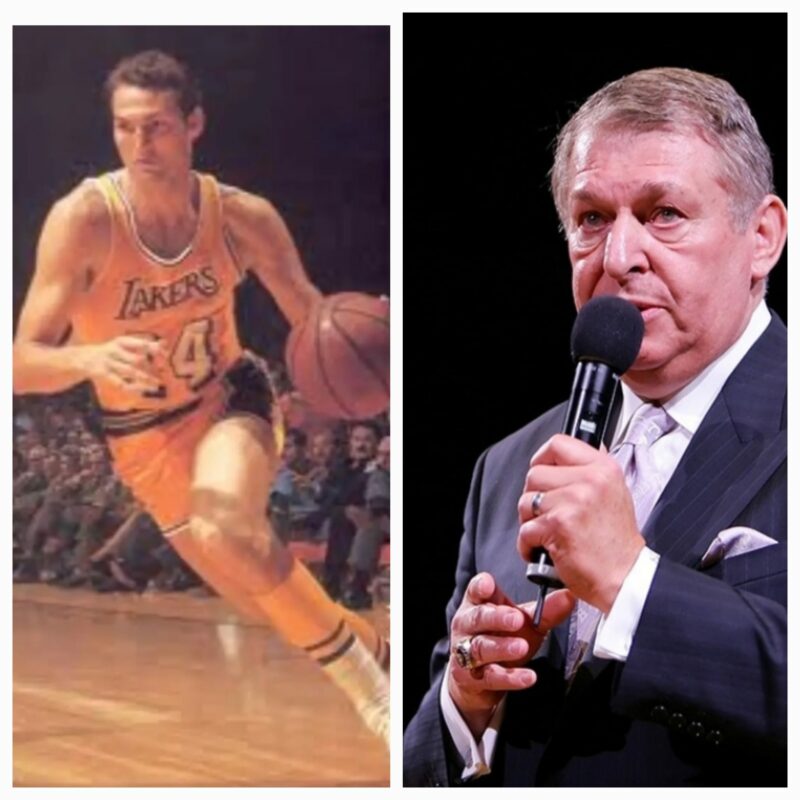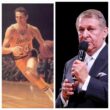The Icon Jerry. Growing up, like many kids passionate about sports, I had my heroes. In baseball, there were countless that inspired. In basketball, there were fewer. One of my earliest idols was Jerry West. As a young player, I tried to emulate his moves and style as best as I could. One particular aspect stood out to me, something I could never quite master despite repeated efforts
Quite simply, basketball players have their favorite “shooting spots” on the court where they feel most confident. Jerry had his own spots, and anyone familiar with basketball back then knew he would aim to dribble to one of them to score. What set West apart was his unique and well-crafted technique that allowed him to shoot the ball faster than almost anyone else in the game. This technique was a powerful final dribble, executed while still in motion, which rose to chest height where his hand, already positioned, cocked, under the ball and quickly raising it above his head and releasing it, leaving defenders with no chance to obstruct the shot. I often thought of Jerry as a quick-draw gunslinger, effortlessly taking down any would-be challenger dead in their tracks.
It was a remarkable mechanism that, even after all these years, I have yet to see matched or improved. In addition to his incredible All-Star skills as a scorer, he was also a clever passer and a fantastic team player. Yes, I looked up to him immensely.
Fast forward many years later, long after my playing career had ended, I found myself working for the NY Knicks and attending an NBA Summer League tournament in Los Angeles. This tournament was quite prestigious, drawing all the NBA teams eager to scout new talent. I vividly recall this event because, while sitting in the stands next to my esteemed boss, Mr. Ernie Grunfeld, the President of the NY Knicks and a former NBA player, I held my breath as I saw Jerry West enter the relatively small arena. He scanned the crowd and casually made his way up the steps to where we were seated. He greeted Grunfeld. Then took the seat right beside me! For a full five minutes, I was so stunned that I couldn’t breathe, move, or even turn my head. In that moment, with a childhood idol by my side, I became a kid again.
After the game, he rose, exchanged a few words with Grunfeld, said his goodbyes, and left. I hadn’t been introduced. Later I realized I was fine with that; I likely would have stammered or even forgotten my own name, a stunned almost frozen ten-year-old in a grown-up’s body, too overwhelmed to speak. That moment will stay with me forever.


Jerry West was a true icon in the world of basketball. Here are some noteworthy aspects of his story and the reasons why I always have had him on a pedestal:
- He Wasn’t the Top Pick
Even though Jerry West is celebrated as one of the greatest players in NBA history, he was not the first overall selection in the 1960 NBA Draft. That distinction went to Oscar Robertson, (another of my idols) who was chosen by the Cincinnati Royals. West was picked second by the Minneapolis Lakers, who were on the verge of moving to Los Angeles.
- He Had Reservations About Joining the Lakers
Hailing from West Virginia, West had spent his entire life on the East Coast and was not particularly excited about relocating to Los Angeles. He even questioned whether the Lakers would remain in L.A. for the long haul, and the city was not yet recognized as a basketball hub.
- The Lakers Considered Another Player
The story goes that before settling on West, the Lakers gave serious thought to drafting Darrall Imhoff, a 6’10” center from the University of California. Imhoff was well-regarded, but ultimately, the Lakers couldn’t overlook West’s exceptional talent.
- He Wasn’t Universally Recognized as a Star
In contrast to today’s thorough evaluations of top prospects, West’s potential was not universally acknowledged at the time. Some scouts felt he lacked the assertiveness needed to be a standout in the NBA. However, his remarkable dedication and skill soon proved those skeptics wrong.
- His Iconic Silhouette Eventually Became the NBA Logo
Although this occurred long after he hung up his sneakers, it’s remarkable that West, became the emblem of the league through the NBA’s official logo. The silhouette featured in the design is inspired by a well-known photo of West in the act of dribbling.
Accomplishments
NBA Champion (1972)
NBA Finals MVP (1969) – He was the only player to win it while on the losing team
10x NBA First-Team Selection
14x NBA All-Star
4x NBA All-Defensive Team
NBA Scoring Champion (1970) – 31.2 PPG
NBA Assists Leader (1972) – 9.7 APG
And finally his Career Stats: 27.0 PPG, 6.7 APG, 5.8 RPG
*He was nicknamed “Mr. Clutch” for his late-game heroics, including a 60-foot buzzer-beater in the 1970 NBA Finals. He led his team to 9 NBA Finals, but won just once (1972), often facing the Bill Russell-led Boston Celtics dynasty.
After Retirement
- He became One of the Most Accomplished Executives in NBA Draft History
In his role as an executive, he played a key part in drafting and acquiring some of basketball’s greatest stars, such as Magic Johnson, Kobe Bryant, and Shaquille O’Neal. His keen eye for talent made him just as successful off the court as he was during his playing days.
For a man that was not really adept at dribbling with his left hand he became a respected and an All Star player and yes a NBA icon.


The Other Jerry: A Remarkable Sports Executive
Admiration is the mature form of idolization, and that’s exactly what I felt for Jerry Colangelo during my tenure with the family run Phoenix Suns. Back then, in what was known as America West Arena he was the President/CEO and head of the franchise and his office, designed specifically for him, in that beautiful construction was not guarded by a secretary. It was guarded by two separate secretaries and both of them had to grant you access to his lavish workspace.
As I remember it was a beautifully crafted, air-conditioned area filled with trophies and which featured two balconies of which I had the privilege to visit while he allowed me to enjoy a smuggled in, Cuban cigar.
In our Phoenix work circle, the President was affectionately and very respectfully known as “The Pope” as in, “Does anybody know if The Pope is coming to our scouting meeting today?”
Before I detail Jerry “The Pope” Colangelo’s achievements there is this episode I need to recount.
The Time: The Spring 2001.
The Location: The Five Star Grand Hotel Majestic gia’ Baglioni in Bologna, Italy.
The Mission: After a call from Bryan Colangelo, the General Manager of the Phoenix Suns, I was instructed to fly from Spain to Italy without delay. My only itinerary item was to attend a practice session for the Benneton Treviso team, led by coach Mike D’Antoni, to assess NBA draft prospect Nikoloz Tskitishvili. I should mention that I wasn’t particularly convinced about this player’s NBA potential.
The Twist: On the day of the event, I was informed by reception that, deviating from the usual protocol, a car and driver would pick me up. At 3 PM, a limousine pulled up at the hotel, and the back window rolled down to reveal, SURPRISE, our President, the “Pope” Jerry Colangelo, whom I had previously only very briefly met! As I got into the car, he casually remarked, “Hi Tim, let’s go check out this Nikolaz, and why don’t you share a bit about yourself?” My mind went blank, and I honestly can’t recall what I said, but I do remember admitting I wasn’t a fan of the player.
The Conclusion: Immediately after watching the practice, as we were heading back to the limousine, Colangelo’s phone rang. It was his son Bryan, the same son who had hired me and who was a convinced supporter of the player. I only caught the President’s side of the conversation, where he said, “I agree with Tim.” It felt surreal to have the President on my side against his own son. But hey! I hoped life would go on.
The Lesson: The player ended up being the #5 pick in that draft (by Denver) but only lasted four seasons in the league, playing 172 out of the possible 328 games. He averaged 2.9 points and 1.8 rebounds during his brief career.
Turns out, the President and I were right!
Yes, Jerry Colangelo who presently is the chairman for the Naismith Basketball Hall of Fame, is a standout figure in American sports, boasting an impressive career that includes the NBA, MLB, and USA Basketball. From his roots in Chicago to founding the Phoenix Suns and revitalizing Team USA, his legacy is defined by visionary leadership and outstanding accomplishments.
Chicago Origins
- Early Career: Growing up in a working-class Italian-American family in Chicago, he developed a love for sports early on. His college basketball experience honed the skills that paved the way for a successful career in sports management. He began his journey in the front office with the Chicago Bulls, where he held various positions including scout, assistant to the president, and marketing specialist.
Phoenix Suns (1968–2004) – The Architect of Success
- 1968: At just 28 years old, Colangelo made history as the youngest general manager in professional sports when he took charge of the newly formed Phoenix Suns.
- 1972: He became the owner of the team after successfully negotiating the purchase of the Suns.
- 1988: Played a key role in acquiring Charles Barkley, which propelled the team to the NBA Finals in 1993.
- 2004: Concluded an impressive 36-year career with the Suns.
Key Achievements with the Suns:
Developed one of the most reliable teams throughout the ’70s, ’80s, and ’90s.
He brought in stars like Charles Barkley, Steve Nash, Kevin Johnson, and Amar’e Stoudemire.
Guided the Suns to their inaugural NBA Finals in 1976 and again in 1993.
Played a pivotal role in popularizing the fast-paced “Seven Seconds or Less” Mike D ‘Antoni offensive style.
MLB – Arizona Diamondbacks (1995–2004)
- 1995: Introduced Major League Baseball to Arizona.
- 1998: The Arizona Diamondbacks kicked off their inaugural season.
- 2001: Just four years post-establishment, the Diamondbacks clinched the World Series title, triumphing over the Yankees in a thrilling seven-game series.
* Colangelo’s daring moves, such as signing Randy Johnson and Curt Schilling, transformed the Diamondbacks into champions faster than any other expansion team in history.
Team USA Basketball – The Redeem Team (2005–2016)
- 2005: Became Chairman of USA Basketball following the U.S. Olympic team’s disappointing bronze medal in 2004.
- 2008: Created the “Redeem Team,” featuring stars like Kobe Bryant, LeBron James, and Dwyane Wade, which clinched gold at the Beijing Olympics.
- 2012 & 2016: Guided Team USA to consecutive Olympic gold medals, reinforcing their dominance.
Colangelo Team USA’s strategy was to foster a renewed culture of dedication, discipline, and teamwork to restore USA supremacy in basketball.
Legacy & Hall of Fame Recognition
- 2007: Inducted into the Basketball Hall of Fame.
- 2014: The NBA named its Team USA training facility in his honor.
- 2020: Contributed to Phoenix being selected to host the 2024 NCAA Final Four.
Colangelo is celebrated as one of the most impactful sports executives ever, influencing various franchises, leagues, and the global basketball scene.
Intriguing Anecdotes
Declined Michael Jordan (1999) – When MJ sought a second comeback, Colangelo, as the Suns owner, graciously opted not to sign him.
Supported Steve Nash’s MVP Journey – His belief in Nash helped transform Phoenix into an offensive powerhouse.
Nearly Became NBA Commissioner – He was once a candidate for the NBA’s top position but chose to remain in Phoenix.
Jerry Colangelo’s career, which is admirable, exemplifies vision, leadership, and the creation of winning cultures across basketball, baseball, and international arenas.
He is a quiet American icon.
In conclusion, the two Jerrys were directly and indirectly an influential ingredient of my life experience.
Both signified, in their own special way, greatness.
Both were proven examples of excellence on and off the basketball court.
With West it personally proved the adage that, “imitation is the highest form of praise”.
With Colangelo it was watching and learning from him the importance of calm objectivity.
Yes, the two Jerrys remain, even today, especially inspiring.
Artículos de opinión
Redes sociales:
X: @TimShea03304927
Facebook: Tim L Shea
Instagram: tim.shea49









